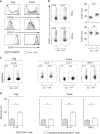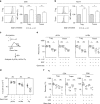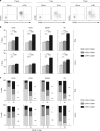Profiling the lymphoid-resident T cell pool reveals modulation by age and microbiota
- PMID: 29302034
- PMCID: PMC5754350
- DOI: 10.1038/s41467-017-02458-4
Profiling the lymphoid-resident T cell pool reveals modulation by age and microbiota
Abstract
Despite being implicated in non-lymphoid tissues, non-recirculating T cells may also exist in secondary lymphoid organs (SLO). However, a detailed characterization of this lymphoid-resident T cell pool has not yet been done. Here we show that a substantial proportion of CD4 regulatory (Treg) and memory (Tmem) cells establish long-term residence in the SLOs of specific pathogen-free mice. Of these SLOs, only T cell residence within Peyer's patches is affected by microbiota. Resident CD4 Treg and CD4 Tmem cells from lymph nodes and non-lymphoid tissues share many phenotypic and functional characteristics. The percentage of resident T cells in SLOs increases considerably with age, with S1PR1 downregulation possibly contributing to this altered homeostasis. Our results thus show that T cell residence is not only a hallmark of non-lymphoid tissues, but can be extended to secondary lymphoid organs.
Conflict of interest statement
The authors declare no competing financial interests.
Figures







Similar articles
-
Distinct lymphokine production by CD4+ T cells isolated from mucosal and systemic lymphoid organs.Immunology. 1993 Dec;80(4):574-80. Immunology. 1993. PMID: 7905860 Free PMC article.
-
Transcriptional Regulation of Tissue-Resident Lymphocytes.Trends Immunol. 2017 Feb;38(2):94-103. doi: 10.1016/j.it.2016.11.004. Epub 2016 Dec 9. Trends Immunol. 2017. PMID: 27939451 Review.
-
Enhanced renewal of regulatory T cells in relation to CD4(+) conventional T lymphocytes in the peripheral compartment.Immunology. 2016 Feb;147(2):221-39. doi: 10.1111/imm.12555. Epub 2015 Dec 17. Immunology. 2016. PMID: 26572097 Free PMC article.
-
Chemokine-mediated control of T cell traffic in lymphoid and peripheral tissues.Mol Immunol. 2005 May;42(7):799-809. doi: 10.1016/j.molimm.2004.06.040. Epub 2004 Nov 23. Mol Immunol. 2005. PMID: 15829268 Review.
-
Stimulation of antigen-specific T- and B-cell memory in local as well as systemic lymphoid tissues following oral immunization with cholera toxin adjuvant.Immunology. 1993 Oct;80(2):197-203. Immunology. 1993. PMID: 7505255 Free PMC article.
Cited by
-
Lymph node γδ and αβ CD8+ T cells share migratory properties.Sci Rep. 2018 Jun 12;8(1):8986. doi: 10.1038/s41598-018-27339-8. Sci Rep. 2018. PMID: 29895956 Free PMC article.
-
Runx3 drives a CD8+ T cell tissue residency program that is absent in CD4+ T cells.Nat Immunol. 2022 Aug;23(8):1236-1245. doi: 10.1038/s41590-022-01273-4. Epub 2022 Jul 26. Nat Immunol. 2022. PMID: 35882933
-
Type 1 interferons and Foxo1 down-regulation play a key role in age-related T-cell exhaustion in mice.Nat Commun. 2024 Feb 26;15(1):1718. doi: 10.1038/s41467-024-45984-8. Nat Commun. 2024. PMID: 38409097 Free PMC article.
-
Mouse Microbiota Models: Comparing Germ-Free Mice and Antibiotics Treatment as Tools for Modifying Gut Bacteria.Front Physiol. 2018 Oct 31;9:1534. doi: 10.3389/fphys.2018.01534. eCollection 2018. Front Physiol. 2018. PMID: 30429801 Free PMC article. Review.
-
Metformin in therapeutic applications in human diseases: its mechanism of action and clinical study.Mol Biomed. 2022 Dec 9;3(1):41. doi: 10.1186/s43556-022-00108-w. Mol Biomed. 2022. PMID: 36484892 Free PMC article. Review.
References
Publication types
MeSH terms
Substances
LinkOut - more resources
Full Text Sources
Other Literature Sources
Medical
Research Materials

